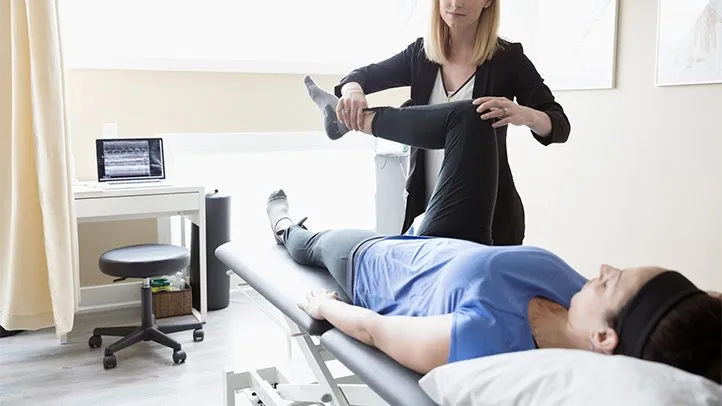Book Appointment Now

Physiotherapy for Sciatica: Your Path to Pain Relief in Jammu
Hello, my name is Dr. Gaurav Vaid, and I’m a physiotherapist working and residing in Jammu. At my physiotherapy clinic, Swasthya Shastra, the goal of every team member is to create effective healing strategies through tailored treatment solutions and correct sciatica management techniques for each individual.
Sciatica is a common ailment that affects a large portion of the population and can severely limit one’s mobility. If you are feeling sharp, shooting pains in your lower back that run down your leg, accompanied by numbness that may make you feel like you are not in control of your body, you may have sciatica. But don’t worry, you have physiotherapy here in Jammu, which will allow you to return to the dynamic lifestyle you deserve.
Understanding Sciatica
Sciatica refers not to a condition but to a symptom stemming from irritation or compression of the sciatic nerve. This is a large nerve that is formed in the lumbar region, passes through the gluteal area, and descends posteriorly along both legs. Sciatic nerve problems may result from several factors:
- Herniated or Bulging Disc: It is a common occurrence that results when the soft cushioning material between the spinal vertebral bones protrudes, pressing against a nerve.
- Spinal Stenosis: The spinal canal narrowing can exert pressure on the sciatic nerve.
- Piriformis Syndrome: The piriformis muscle, located in the buttocks, might spasm or tighten, compressing the nerve. This incident is what we would refer to as Piriformis Syndrome.
- Bone Spurs: These abnormal bony outgrowths on vertebrae may also exert pressure on the nerve. These are called bone spurs.
- Injury: In some cases, trauma directly to the hip or lower back can lead to sciatica, known simply as Injury.
Symptoms of Sciatica
Observably, a sciatica patient also suffers from:
- Lower back pain: Often shooting down to the buttocks and legs.
- Numbness or tingling: One leg or foot becoming devoid of sensations is referred to as Numbness or Tingling.
- Muscle weakness: Weak limbs are defined as a lack of ability to move the foot or leg.
- Sharp or burning pain: A stabbing or burning feeling, while sitting down or getting to a standing position, is perceptible.
Also, read Physiotherapy for Knee Pain: Best Treatments & Exercises
Physiotherapy Treatments for Sciatica
A physiotherapy specialist must take responsibility for managing sciatica while a patient is diagnosed with such a condition. The main focuses need to take into account alleviation of pain, restoration of mobility, and augmentation of muscle strength that support the back. Efficient physiotherapeutic treatment encompasses:
- Patient Education: Taking courses of action alongside their guidance to mediate sciatica if deemed chronic. Schooled patients on adapting appropriate measures guided by therapists, like body position and posture, can reduce the chance of having more recurrences of sciatica.
- Manual Therapy: Techniques like spinal mobilization can lessen irritation of the nerve and help improve the motion range.
- Exercise Therapy: Individually prescribed exercises aimed at improving core and back muscle strength, thereby enhancing spinal support.
- Modalities: Application of either hot or cold means to treat inflammation and pain.
Effective Exercises for Sciatica
Routinely incorporating certain activities can help relieve the symptoms of sciatica. Here are some exercises to try:
- Pelvic Tilt: Aids in the development of the musculature of the lower back and enables the alignment of the pelvis.
- Begin lying on your back with knees bent.
- Tense your abdominal muscles.
- Lift your lower back onto the floor.
- Relax after holding for a few seconds.
- Repeat 10 to 15 times.
- Knee-to-Chest Stretch: Elongates and relaxes the lower back and alleviates tension.
o Start in a supine position.
o Lift one knee to your chest, grasping it with both hands.
o Maintain this position for 20 to 30 seconds.
o Perform on both legs 3 times each. - Piriformis Stretch: Targets the piriformis muscle, which has the potential to aggravate the sciatic nerve.
- Start in a supine position with knees bent.
- Place the ankle of the affected leg over the opposite knee.
- Bring the knee towards your chest.
- Hold this position for 30 seconds.
- Repeat thrice.
- Glute Bridge: Works the gluteal muscles and lower back.
- Start in a supine position with knees bent and feet firm on the floor.
- Lifting your hips towards the ceiling, squeezing your glutes.
- Keep the position for a few seconds.
- Slowly lower back down.
- Repeat this step 10-15 times.
- Child’s Pose: A less-intensive stretch for the lower back.
- Kneel on the ground.
- Begin by sitting back on your heels and stretching your arms forward.
- Bend your torso down towards the floor.
- Stay in this position for 30 seconds.
- Do the same thing 3 times.
Low-Impact Aerobic Activities
Moderate physical activities can also have positive effects on joint and back problems:
- Walking: It is a good exercise to make your joints more flexible and to reduce pain. Initially, you need to walk short distances and then gradually increase the distance.
- Swimming or Water Aerobics: The water is a great way to relax all the muscles and joints without putting them under the pressure of the body.
- Cycling: A stationary bicycle can promote the muscle strength of the legs and the back.
Preventive Measures
To avert sciatica or lessen its recurrence:
- Correct Posture: Sitting and standing correctly is important in preventing sciatica.
- Physical Activity: Muscle groups of the core and the back have to be catered to mainly during the cancer treatments.
- Right Weight: Keeping the body mass within the normal range is a very effective way of pain relief from the spine.
- Do Not Sit for Long: At regular intervals, get up and stretch, and in case of long-term sitting, which is recommended in the posture.
When to Seek Medical Attention
Even though physiotherapy and exercises are beneficial in the management of sciatica, it is imperative to consult a healthcare expert in the following scenarios:
- The pain is still present despite attempts by the patient to heal without resorting to surgical intervention.
- The situation becomes increasingly more difficult over several days, weeks, or months.
- There is a pronounced and constant feeling of weakness or a loss of sensation in the legs, feet, and the affected area.
- Uncontrolled loss of both normal movements and sensations in the lower parts of the body occurs.
Your Journey to Sciatica Relief Starts Here in Jammu
Enduring the pain of sciatica is indeed a hard thing, but do know that you do not have to go through it alone. At Swasthya Shastra, Dr. Gaurav Vaid and his team believe that “the health of Jammu’s community is our purpose”. The doctors exclusively care for the people of Jammu with the help of locally available treatments to achieve the best results possible.
If you have sciatic pain, the best option for you is to connect with Swasthya Shastra. We will then team up to figure out the root cause of your pain to create a tailor-made treatment plan that can solve the issue of your mobility and lessen your discomfort, alongside improving your quality of life in Jammu.
For further queries, please reach out to Dr Gaurav Vaid or Swasthya Shastra.


